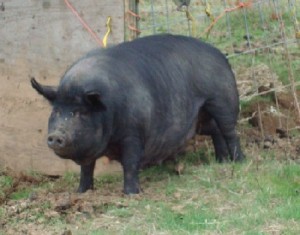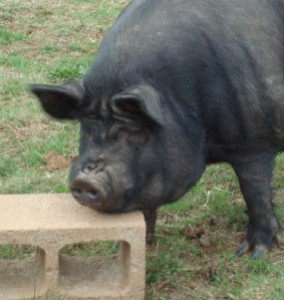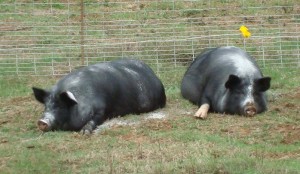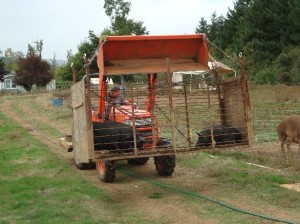Any ideas what could possibly be the answer to that question that would fit in here at the farm?
If you never heard of a small black farm hog let me be the first to introduce you to the super practical, very rare and “just back from the brink of extinction” American Guinea Hog!!
They are a small hog that weighs just 200-300 lbs tops at maturity. Typical butcher size at about 6 months of age yields a carcass of about 75 lbs hanging weight. Of course like any hog, you can grow them out longer to get a bigger carcass if you want one.

Guinea hogs are considered a lard hog which means that they make alot of lard in addition to their meat. These animals might have been the original homesteading hog. They are small (which makes them easy to transport across the country), they are gentle (very important for farming families and their kids), they require very little food and are excellent foragers (important when livestock feed is scarce, expensive or unavailable) and at the end of it all, they produce a nice amount of meat with a good portion of fat for rendering. Lard was used for so many things on a farm. It was for cooking and candle making and soap making and all sorts of things. If you didn’t have a hog that produced good amounts of fat, you were going to be going without some very important items in your household.
As families started moving off the farms and into the cities, there were fewer people keeping these small hogs. Additionally, as pork producers moved their animals into the big “factory farms” and the demand was for lean pork, these old lard hog breeds fell out of favor and they became more and more rare. Eventually this breed dwindled down to just 45 known breeding animals. Luckily for all, the American Guinea Hog has found a place on America’s small farms and homestead once again. While still very much an endangered farm animal breed (listed on the critical list with the ALBC), their numbers are up and breeders are found nationwide. There are even Guinea Hogs up in Alaska.
We had no real intention of buying any other breeds of hogs. We’ve been more then happy with our Red Wattles and our farm has RW’s in just about every field. Ok, I take it back, they are in EVERY pasture on the place. The horses have learned to love them, the cows have learned that they shouldn’t mess with a mature RW hog and her food.. lol. and the chickens have learned that for the most part, hanging with the hogs is a good thing. There is always food to eat from the hog feeders and when the chickens need a warm place to sleep, the back of a RW hog will hold 7 or 8 chickens.

Anyway, back to the AGH’s. Back in August, Guinea hogs started popping up on my radar. They were in photos on a facebook friend. They were in articles in pasture magazines, they were everywhere so it seemed. Jim was wondering if I was coveting some little black Guinea’s. Nope, I told him I was not hog shopping. Honestly I wasn’t!!
One day towards the end of August, I was home alone and Jim got a phone call. He wasn’t home, so the guy on the phone said he would ask me his question instead. Turns out that he and Jim had met at the abatoir that we use several months ago. They had talked and shared “what kind of animals do you have” sorts of things. Jim told Bernard that we had rare hogs called Red Wattles and now months later, Bernard needed to sell his small herd of AGH’s and remembered that. He asked if perhaps we might want to add a second breed to our rare hog endevors.
Oh man, the chance to buy 5 AGH’s just dropped into my lap. I did turn him down at that moment. But a week later after much discussion between Jim and I, we decided that if one rare hog was good, two must be better.. And besides, they aren’t very big and they eat hardly anything. We can feed all 5 of them for less then it takes to feed one big hog.
Where to put them was the immediate problem. So we took a few few corners from one of the horse pastures and made them a quarentine area. They will spend about 30 days in that area, while we make sure they didn’t come with anything that might pass on to the rest of our hogs. They did come with a few lice bugs which we treated for immediately (the white powder you see in some of the pictures), so we are glad they are in their own area for the time being
 Once they get “cleared”, they will be moved down to one side of our lower pasture where they will have good grazing and a small wooded area to forage in. Its our hope that they will be able to provide most of their food themselves. We’ve learned very quickly that too much hog food makes a Guinea Hog very fat!!! And while lard is a great by-product from the market animals, it is not a good thing to have overly fat breeding stock.
Once they get “cleared”, they will be moved down to one side of our lower pasture where they will have good grazing and a small wooded area to forage in. Its our hope that they will be able to provide most of their food themselves. We’ve learned very quickly that too much hog food makes a Guinea Hog very fat!!! And while lard is a great by-product from the market animals, it is not a good thing to have overly fat breeding stock.
